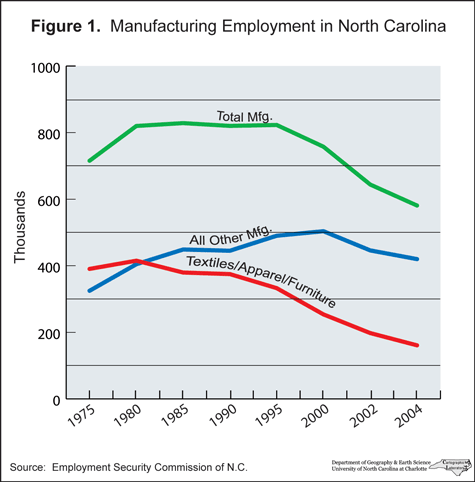Manufacturing
by Alfred W. Stuart
Professor Emeritus of Geography, University of North Carolina at Charlotte, 2006.
Reprinted with permission from The North Carolina Atlas Revisited. Managing editor: Alfred W. Stuart.
Part 4: Declines in Traditional Industries
 The reason for North Carolina’s longer slide in factory employment than in the nation as a whole is that its traditionally major, labor-intensive industries have been losing ground for many years. In 1975, for example, their major representatives, the textiles, apparel and furniture industries (North American Industry Classification System (NAICS) industries 313,314,315, and 337), together accounted for the majority (54.6 percent) of the state’s manufacturing employees. This proportion has declined steadily to their 28 percent share in 2004. Collectively, these three industries lost over 213,000 jobs between 1975 and 2004, whereas all other manufacturing industries added over 100,000 jobs (Figure 1). More recently, these “other industries” have shared in the national industrial downturn, losing over 103,000 jobs since their statewide peak, which occurred in 1998.
The reason for North Carolina’s longer slide in factory employment than in the nation as a whole is that its traditionally major, labor-intensive industries have been losing ground for many years. In 1975, for example, their major representatives, the textiles, apparel and furniture industries (North American Industry Classification System (NAICS) industries 313,314,315, and 337), together accounted for the majority (54.6 percent) of the state’s manufacturing employees. This proportion has declined steadily to their 28 percent share in 2004. Collectively, these three industries lost over 213,000 jobs between 1975 and 2004, whereas all other manufacturing industries added over 100,000 jobs (Figure 1). More recently, these “other industries” have shared in the national industrial downturn, losing over 103,000 jobs since their statewide peak, which occurred in 1998.
The greater and more long-term losses in the three traditional industry groups involves several sets of factors. First, they reflect the vulnerability of these labor-intensive industries to foreign competition, in great part because of their previously noted low levels of productivity. For many years these industries enjoyed comparative advantages domestically in terms of operating costs, especially labor costs. However, in the recent era of globalization, a number of foreign countries offer even greater operating costs savings. Further, the technology of these industries can be transferred relatively easily and adopted by rural labor forces. Thus, the US industries have been faced with a rising tide of less expensive imports in cloth, clothing and furniture. Domestic consumers have become accustomed to buying these items from China, Brazil and other countries.
Ironically, this trend is very similar to the late 19th and early 20th century shift of the cloth industries from New England to the South. Some 40 countries are now free to ship unrestricted amounts of textiles to US stores.
Within the labor-intensive industries, especially textiles, job losses are not always solely a function of losing markets to foreign competitors. Many of the better managed and more highly capitalized companies have invested heavily in new technologies that dramatically increased their productivity, thus allowing them to stay competitive with their offshore counterparts. However, the point of these investments is to reduce labor costs and employment, thus adding to the number of job losses.
These trends produced a geographic shift that occurred within the state for several decades after World War II. As shown in the North Carolina Atlas: Portrait for a New Century (pp. 183-184), many textile and apparel operations opened facilities in rural parts of the Coastal Plains and the Mountains during this time. These locations represented a search for cheaper labor by companies that found it too expensive to compete for workers in the growing, increasingly more diverse economies in the original heartland of the cloth industries, the Piedmont corridor. This era of rural industrialization ended in the early 1970s as offshore sites began to offer even lower operating costs. By 2003, North Carolina's Metro areas contained 67 percent of the state's manufacturing jobs, a sharp increase from their 48 percent share in 1975.
It is often stated that the reason for the loss of manufacturing jobs in the state is the enactment of the North American Free Trade Agreement (NAFTA). The fact is that employment declines in the more vulnerable labor-intensive industries, such as the textiles, apparel, and furniture sectors, began long before NAFTA was enacted. Textiles employment in North Carolina peaked in 1973, apparel in 1984 and furniture in 1988. Between these peak years and 1991 these three industry groups together lost over 112,000 jobs. NAFTA may have contributed to some of the subsequent jobs losses since 1991 but does not appear to be the primary reason for most of the losses in those industries.
Keep reading >> Manufacturing- Part 5: Specialization ![]()
1 January 2006 | Stuart, Alfred W.